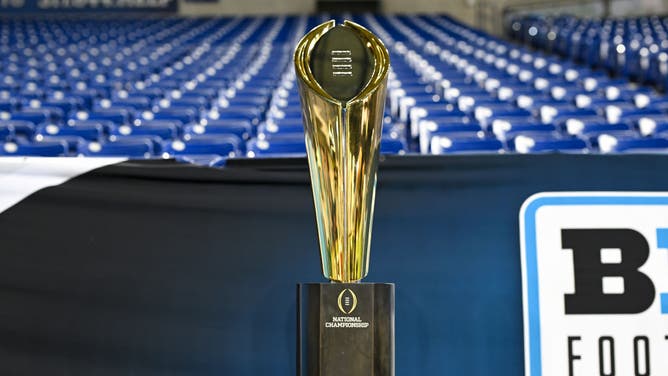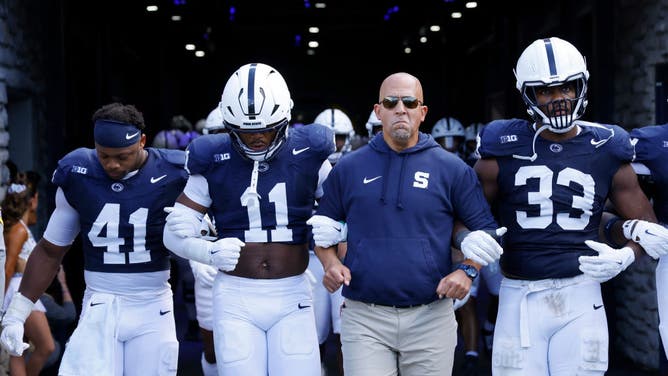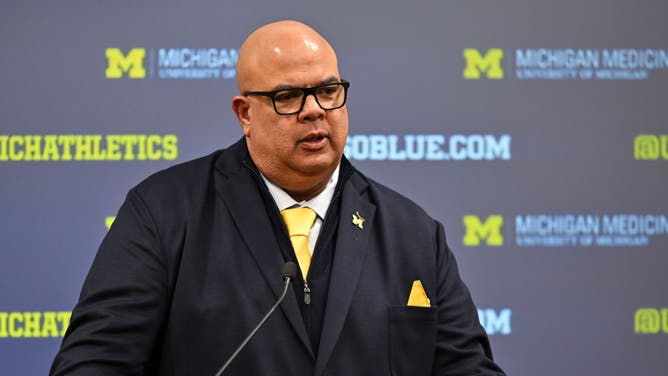We support our Publishers and Content Creators. You can view this story on their website by CLICKING HERE.
As we continue down this wild path towards the college football playoff, it’s becoming clearer by the day that the committee is winging this whole seeding process over the last few weeks. If you weren’t convinced of that as you listened to CFP chair Warde Manuel explain the reasoning why some teams are ranked higher than others, then you aren’t paying attention.
I have wondered aloud where strength of schedule would factor into the process for committee members sitting in a suite in Grapevine, Texas over the past month. Judging by the comments made by Warde Manuel, we are headed towards a complicated finish that will have a few teams wondering where they are drawing conclusions as to which are the best 12-teams in the country.
One of the most fascinating arguments have centered around the Big Ten’s schedule, and how that will play a factor in the final rankings that are released following championship weekend in three weeks. As the SEC currently sits at five 2-loss teams heading into another pivotal Saturday of action, one can only wonder how previous games are coming into play when deciding on which teams should be given a spot in the weekly rankings.

The College Football Playoff (CFP) Championship trophy sits on display during the 2024 Big Ten Media Days on July 23, 2024 at Lucas Oil Stadium in Indianapolis, IN. (Photo by James Black/Icon Sportswire via Getty Images)
And let’s be clear, the only rankings that truly matter are going to be the ones released after conference title games are played. But, the CFP committee has not done itself any favors by seemingly overlooking how some teams have gotten to this point in the season with their win-loss records.
Does The CFP Committee Look At Strength Of Schedule? They Don’t
While Penn State came in at No. 4 in Tuesday’s ranking, folks around the country are wondering what the Nittany Lions have done so far this season to earn that spot. Was it going on the road and beating a bad USC team? What about having a quality loss at home to Ohio State, where the Nittany Lions scored only six points in the final three quarters of action?
Maybe it was the win over Washington that did it. You know, the team that played for a national championship last season, as some like to characterize. But this is not 2023, and the Huskies are 6-5. Oh, and Indiana’s biggest win of the season so far was against that same Washington team, and the only win it has over a team with an above .500 winning percentage this season.
Let that one sit for a while. Just for clarity, I’m not implying Indiana is not deserving to be in the Top-12, it does. But when Warde Manuel decided to classify Indiana’s close victory over Michigan as a ‘Big Win’ you have to start questioning the mindset and criteria that this committee is using. If the Hoosiers go into Columbus this weekend and beat Ohio State, then the discussion is over, they will make the playoffs.

Penn State Nittany Lions head coach James Franklin walks to the field with his players before the second half of a college football game against the UCLA Bruins on October 5, 2024 at Beaver Stadium in University Park, Pennsylvania. (Photo by Joe Robbins/Icon Sportswire via Getty Images)
But if they were to lose by two touchdowns to the Buckeyes, are you telling me they are one of the best 12 teams in the country? Save me from that nonsense, as much as I like the Curt Cignetti story, and the Hoosiers overall. For Penn State to clinch its spot in the playoff, it must finish its daunting schedule that includes Minnesota and Maryland.
Whew, that’s tough.
Though it’s the answer from CFP chair Warde Manuel when asked by Reece Davis about what is ‘carrying the day’ when it comes to how the committee is discussing the rankings that really sets the tone.
“I think watching the games and watching the teams play carries the day for most of us.. “We look at the data, we look at the stats, we see how other people compare and strength of schedules and all of those things,” Warde Manuel noted. “But we also have to watch the games and see how teams are performing in all facets of the game.
“That lends itself to the discussion of how people see the teams perform. And it’s a lot of debate, a lot of discussion. People see different ways. But that’s the value of having 13 members of this committee in the discussion that goes on.”
I Know Folks Are Tired Of Hearing About The SEC, Outside The South
I get it, folks think there is a bias towards the SEC because commissioner Greg Sankey likes to throw his weight around when possible. But it’s clear in 2024 that the ‘bias’ has shifted to the Big Ten, judging by the current rankings.
While the SEC has four teams that would be in the playoffs if they started today, there is still a lot of chaos that is bound to ensue that will cause some finagling. Right now, there is a scenario where all hell could break loose, and the conference would reshuffle its teams that would be part of the postseason.
At the moment, Ole Miss, Georgia, Alabama and Texas are in. But that could change this weekend, or on championship Saturday, which would cause folks at the SEC office in Birmingham to lose their minds. If Tennessee wants to play for a national championship, it needs a little help.
The easiest way for that to happen is for the Vols to take care of business over the next two weeks. Then, there are a few different options. Florida beating Ole Miss on Saturday would solve that problem real quick, but I don’t expect the Rebels to lose in Gainesville. What about Texas losing next week in College Station to Texas A&M? Sure that’s another scenario, while outside the conference chaos could also likely do the trick.
If Notre Dame were to lose this weekend to Army, the Fighting Irish could go ahead and make Christmas plans with their families. Because honestly, I don’t know how the committee has forgotten about that loss to Northern Illinois. On the other hand, if a Big Ten team, outside of Oregon, were to slip-up over the next two weeks, the door could be opened for the Vols to slide right in.
College Football Playoff Committee Has No Clear System
But here’s another problem with this whole ‘SEC Dilemma’. For some odd reason, ESPN has classified the Texas victory over Arkansas as a ‘Key Win’. But on the flip side, Tennessee losing to Arkansas is classified as a ‘Bad Loss’. I have no idea what the thought-process behind this was, and I don’t think the broadcast knew either.
The main problem is that teams in the SEC have beaten each other up over the season, and trying to define one win as bigger than the other is a pretty hard task, which has to drive them insane when the committee is trying to justify it.

CFP Chair Warde Manuel seems lost when trying to explain playoff rankings (Photo by Luke Hales/Getty Images)
If we’re looking at this correctly, it’s obviously clear that the college football committee is doing this on-the-fly. each week, not really worrying about what transpired in September and October, or even three weeks ago.
I’m just warning you right now that nothing about the committee rankings make much sense if strength of schedule was an overwhelming factor in how they are putting together the 12-team field.
And for that point alone, it should scare the living hell out of a few teams fighting to stay in contention, while others are loving this method.

 Conservative
Conservative  Search
Search Trending
Trending Current News
Current News 





